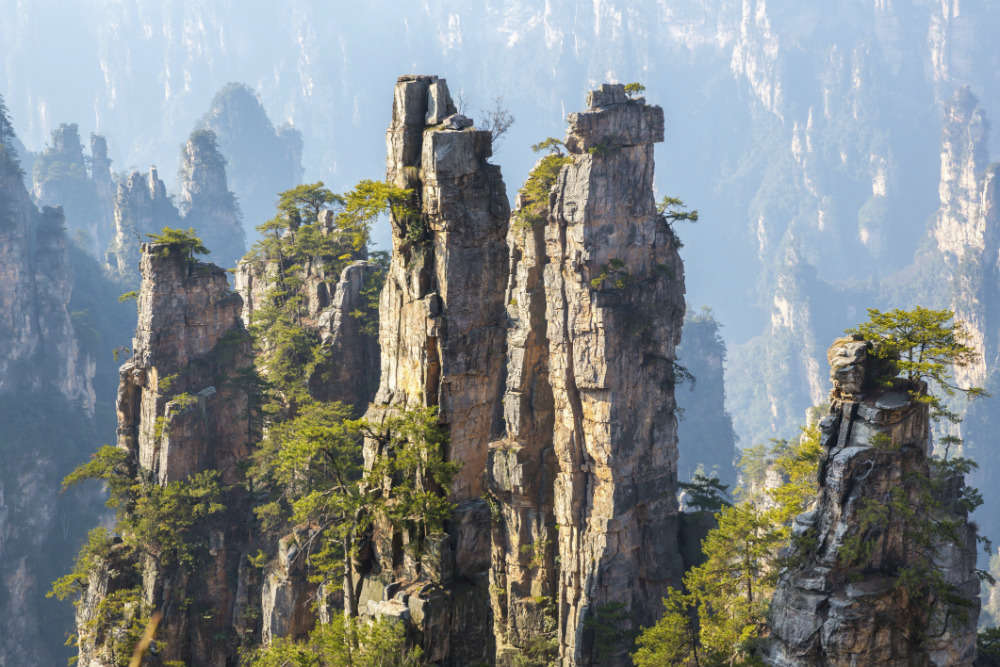
Why Does Zhangjiajie Look Like That?
The Zhangjiajie National Forest Park in China is famous for its towering sandstone pillars, shrouded in mist and seemingly defying gravity. These otherworldly formations make the park look like something out of a fantasy film. But how did these incredible geological wonders come to be?
Sedimentary Deposition Followed by Erosion
The answer lies in a fascinating geological story that spans hundreds of millions of years. The process can be broadly summarized as follows:
- Sedimentary Deposition:
- Around 1.5 billion years ago, the area that is now Zhangjiajie was a vast ocean basin.
- Rivers carried immense amounts of sand, mud, and other sediments into this basin.
- Over millions of years, these sediments were deposited layer upon layer at the bottom of the ocean.
-
The weight of the overlying layers compacted the lower layers, eventually forming sedimentary rocks like sandstone and shale.
-
Uplift and Exposure:
- Roughly 380 million years ago, powerful tectonic forces caused the Earth's crust to uplift in this region.
-
The ocean basin gradually receded, and the sedimentary rock layers that had formed on the ocean floor were thrust upwards, becoming exposed to the elements.
-
Erosion and Weathering:
- Once exposed, the sandstone formations became subject to the relentless forces of erosion and weathering.
- Wind, rain, and ice gradually wore away at the softer layers of rock.
-
The quartz "cement" that bound the sandstone grains together played a crucial role. In areas where this cement was more abundant, the sandstone was more resistant to erosion.
-
Formation of Pillars:
- Over millions of years, the differential erosion of harder and softer rock layers sculpted the landscape into the dramatic pillars we see today.
- The pillars vary in height and shape, creating a breathtaking, surreal vista.
The Role of Quartz Sandstone
The type of rock found in Zhangjiajie is key to understanding the formation of the pillars. It's primarily quartz sandstone, which has some unique properties:
- Quartz Content: Quartz is a very hard, durable mineral that is highly resistant to weathering and erosion.
- Cementation: The quartz grains in the sandstone are bound together by a cement, which is also often made of quartz. This strong cementation makes the rock very strong.
- Joints and Fractures: Like most rocks, the sandstone in Zhangjiajie is not one solid mass but is broken up by joints (vertical cracks) and fractures. These weaknesses provided pathways for water and ice to penetrate and erode the rock.
The Importance of Time
The formation of the Zhangjiajie pillars is a testament to the immense power of geological processes acting over vast stretches of time. The table below provides a simplified timeline:
| Era | Period | Time (Millions of Years Ago) | Geological Event | |---------------|----------------|-----------------------------|--------------------------------------------------------------| | Precambrian | | 1500 - 540 | Deposition of sediments in an ocean basin | | Paleozoic | Devonian | 420 - 360 | Uplift of the region; sandstone layers exposed | | Mesozoic - Cenozoic | Triassic - Present | 250 - Present | Ongoing erosion and weathering, sculpting the pillars |
FAQs
Q1: Are the Zhangjiajie mountains still changing?
A1: Yes, although the changes are very slow. Weathering and erosion are ongoing processes.
Q2: What role do plants play in the landscape?
A2: The vegetation plays a complex role. Plants can both protect the rock from erosion and contribute to it through root growth.
Q3: Are there similar formations elsewhere in the world?
A3: Yes, similar sandstone pillar formations can be found in other parts of the world, including the USA, Madagascar, and Vietnam. However, the scale and beauty of Zhangjiajie make it truly unique.